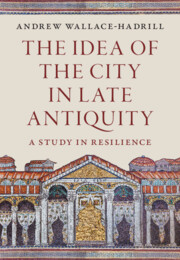Book contents
- The Idea of the City in Late Antiquity
- Praise for The Idea of the City in Late Antiquity
- The Idea of the City in Late Antiquity
- Copyright page
- Dedication
- Contents
- Figures
- Preface
- 1 The End of the Ancient City?
- 2 In Praise of the City
- 3 The City in Question
- 4 The City Revived?
- 5 The City Embattled
- 6 The City and Its Records
- 7 The City of Bishops
- 8 The Grammar of the City
- 9 The Fabric of the City
- 10 Decline and Resilience
- Bibliography
- Index
3 - The City in Question
Published online by Cambridge University Press: 30 January 2025
- The Idea of the City in Late Antiquity
- Praise for The Idea of the City in Late Antiquity
- The Idea of the City in Late Antiquity
- Copyright page
- Dedication
- Contents
- Figures
- Preface
- 1 The End of the Ancient City?
- 2 In Praise of the City
- 3 The City in Question
- 4 The City Revived?
- 5 The City Embattled
- 6 The City and Its Records
- 7 The City of Bishops
- 8 The Grammar of the City
- 9 The Fabric of the City
- 10 Decline and Resilience
- Bibliography
- Index
Summary
It is often suggested that new thinking brought by Christianity spelled the end of ancient ideas of the city. Three Christian authors of the fifth century -- Orosius, Augustine, and Salvian -- have much to say on cities and citizenship. Despite the shock of the sack of Rome, all three are convinced of the value of Roman citizenship, and respond resiliently to the troubles of Rome and other cities of the empire. Augustine’s treatise, the City of God, while offering the Heavenly City and a citizenship in faith as the ultimate aspiration, see it as entangled in the terrestrial world of cities. Salvian is scathing about the moral failings of the city elites, to which he attributes the divine wrath of barbarian devastations, and vividly portrays urban corruption, but in a plea for better cities rather than abandonment of cities.
- Type
- Chapter
- Information
- The Idea of the City in Late AntiquityA Study in Resilience, pp. 74 - 114Publisher: Cambridge University PressPrint publication year: 2025

